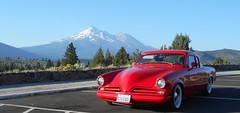(Can't give this post an honest prefix, or it will give away the part of the answer to this puzzle!)
I pulled up to a stop sign recently, slid her into neutral to wait for a gap in the traffic, and my 55 Champion coupe didn't want to go back into gear. I was stuck in neutral. (3 speed manual with a column shifter) The shifter just didn't want to go into first, so I tried reverse. No good. Second? Third? Well, after banging the selector around a bit, I finally got into first, but when I let out the clutch, the car acted like the parking brake was on. I killed the engine trying to take off in first, and the same in reverse. The engine started right back up again. I finally got the car to budge loose, and limped home very slowly. On the mile-long drive toward home, the engine sounded like it had a bad rod bearing: thump, thump, thump . . . very regular at idle in neutral, and the thumping sound sped up with the engine speed when moving. Oddly, the thumping went away entirely if I pushed the clutch in. With the clutch released, the engine at idle sounded smooth and trouble-free, and sounded just as smooth when revved. (The engine is a fresh rebuild with about two hundred miles.)
But going down the road, whether under power or coasting, or just sitting still and idling in neutral with the clutch engaged: thump, thump, thump.
So what are your guesses? I have torn down the offending part now, and I know the source of the problem, but, well, lets just say that my first hunch turned out to be incorrect . . . and my second. I'm hoping some of you will make the same good, but wrong, guesses I did at first, and make me feel better before I reveal what the problem was.
I pulled up to a stop sign recently, slid her into neutral to wait for a gap in the traffic, and my 55 Champion coupe didn't want to go back into gear. I was stuck in neutral. (3 speed manual with a column shifter) The shifter just didn't want to go into first, so I tried reverse. No good. Second? Third? Well, after banging the selector around a bit, I finally got into first, but when I let out the clutch, the car acted like the parking brake was on. I killed the engine trying to take off in first, and the same in reverse. The engine started right back up again. I finally got the car to budge loose, and limped home very slowly. On the mile-long drive toward home, the engine sounded like it had a bad rod bearing: thump, thump, thump . . . very regular at idle in neutral, and the thumping sound sped up with the engine speed when moving. Oddly, the thumping went away entirely if I pushed the clutch in. With the clutch released, the engine at idle sounded smooth and trouble-free, and sounded just as smooth when revved. (The engine is a fresh rebuild with about two hundred miles.)
But going down the road, whether under power or coasting, or just sitting still and idling in neutral with the clutch engaged: thump, thump, thump.
So what are your guesses? I have torn down the offending part now, and I know the source of the problem, but, well, lets just say that my first hunch turned out to be incorrect . . . and my second. I'm hoping some of you will make the same good, but wrong, guesses I did at first, and make me feel better before I reveal what the problem was.




Comment